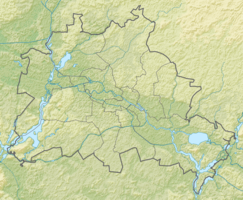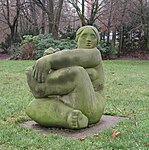Fennpfuhlpark
| Fennpfuhlpark | ||
|---|---|---|
| Park in Berlin | ||
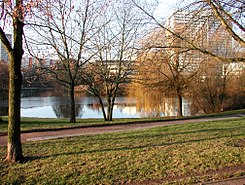
|
||
| Basic data | ||
| place | Berlin | |
| District | Fennpfuhl | |
| Created | 18th century | |
| Newly designed | from the 1970s | |
| Surrounding streets | Paul-Junius-Strasse, Karl-Lade-Strasse, Weißenseer Weg |
|
| use | ||
| User groups | Pedestrians, cyclists, leisure enthusiasts | |
| Park design | Green Space Office | |
| Technical specifications | ||
| Parking area | 92,500 m² | |
|
52 ° 31 '42.2 " N , 13 ° 28' 28.9" E
|
||
The Fennpfuhlpark is a local recreation area in the Berlin district of Fennpfuhl in the Lichtenberg district .
Size and location
The 9.5 hectare park is located between Weißenseer Weg , Paul-Junius-Straße, the extension of Karl-Lade-Straße, Anton-Saefkow-Platz and Landsberger Allee . The park boundaries are not sharply marked, but are flanked by buildings on said streets: At the Paul-Junius-Straße are the community center on Fennpfuhl and two school buildings, one of them, now home to the community college and the music school Lichtenberg , was established in Completed in 1912. In the extension of Karl-Lade-Straße there is a children's facility and a historic villa on the edge of the park, on Anton-Saefkow-Platz the building, which is no longer a department store, with an adjacent food market, residential buildings, a swimming pool and a multifunctional one Gym. On Landsberger Allee in the north, a number of high-rise apartment buildings also border the park. As a result, there is also the indication that the parking area is 14 hectares, which may have something to do with the counting method: two sports fields adjacent to the eastern edge could easily be included in the parking area, as well as the sports hall that is currently being renovated surrounded on all sides by trees and bushes. On the official side, the 9.5 hectares, which the Green Spaces Office is responsible for, are binding.
The center of the park is the Fenn - Pfuhl (also referred to as "new lakes") by merging from the previous Fennpfuhl and the long Pfuhl between the years 1978 and 1981 was and what a small footbridge was built.
Origin and characteristics of the park and related buildings
The park and its use
When the entire area of the village of Lichtenberg was still "jwd" (janz far out, as the Berliners say) in the 18th century, there was an ornamental nursery set up by the commercial nursery owner Gustav Adolph Schultz on part of the area (Roederstraße 14-17) Greenhouses . On the neighboring property, Louis Dittmar produced natural ice blocks from the winter ice surface of the Fennpfuhl , which were then delivered to breweries. His company was called Eiswerke Lichtenberg . Until the early 20th century, the northern Langpfuhl was also used as an ice works for natural ice production. After 1905, the nursery became the property of the Köpp brothers' wood trading company . The areas were now used to store and process wood. The ice cream factories lost their importance with the spread of electric refrigerators and were closed.
The first inns appear around the lake
Between 1891 and around 1905 three innkeepers settled down at the Pfühlen, so in 1891 there was a report of a tavern to the hungry wolf , which was later called Prince Wolfgang . Rowing boat trips were offered for excursion guests, and there was also a gym. In 1901 the excursion restaurant Weltetablissement Lichtenberger Seeterrasse was built (view see web link), which offered space for around 25,000 visitors. A grandstand that led down to the lake and platforms made of wood for orchestras to perform, as well as a wooden observation tower invited the working-class families to enjoy the people on their days off. And finally, old postcards show the existence of Mentes Volksgarten , which opened in 1901 at Roederstraße 28-29 and advertised visitors with the slogan “Berlin's largest and most beautiful natural garden”.
Description and use of the lake
The approximately 1.50 m deep still water has neither an inflow nor an outflow. In connection with the peripheral development in the 1970s and in order to keep the water clean and avoid silting up, a one-kilometer ring line was laid along the bank, which includes 30 taps. The water comes from its own borehole, from which groundwater is pumped from a depth of 30 meters using an electric pump, which is then mixed ( blended ) with the lake water . The water mixture is used by the employees of the Green Space Office to irrigate the park. About 12,000 cubic meters of water evaporate annually from the surface of the water, which can be constantly replenished. The heart of the water cycle is a three-meter-high pressure tank that is enclosed on the edge of the park. A minimum pressure of six bar is generated in the ring line in the ten-liter tank . In autumn the ring system is switched off and the pipelines are freed from the water with a compressor. - The pump management is in the hands of the family well company Glaubrecht Pumpen-Service from Lichtenberg.
On the frozen pond there was an official ice rink between 1925 and 1952 , and in 1951 the Berlin championships were even held on the Fennpfuhl. In the GDR era, the small lake was always part of the Lichtenberg May Festival, where children and young people could try out racing canoes under the guidance of experienced trainers.
From the late 1980s a boat rental was set up on the banks of the Fennpfuhl, which continued to exist for a few years after the fall of the Wall . In 2010, a new private operator was found who lent rowing boats in the warm season, but had to cease operations around 2014 due to a lack of demand and high official requirements.
In addition, there has been a fountain system since the 1980s in the southern water basin, which helps aerate the water.
Further development on and in the park
The villa, built in 1905/1906 by the nursery owner Schultz for residential purposes, served as the headquarters of the construction management team when the new construction area was laid out between 1972 and 1984, and they had a few flat barracks built next to them. From 1986 (until April 2007) the villa was used as the registry office of the Lichtenberg town hall . The listed building was acquired in autumn 2007 by a catering company, which, after reconstruction and some spatial changes, turned the villa into a meeting place for residents and a place for stylish family celebrations. In agreement with the district administration, weddings can take place here again since February 2008.
The building barracks from the 1970s were for many years the headquarters of the administration of the former workers' housing cooperative (AWG) Elektrokohle, now WGLi . After this cooperative was able to move into a new building, the barracks were removed and seven trainees from the district set up a small leisure area at this point as part of the urban redevelopment east project , which was released in November 2007 by the building council with the following words (excerpt): " The new green area offers wonderful access to the Fennpfuhl from the south. I am particularly pleased that the training of the gardeners saved costs of 290,000 euros ... “When the inns and factories lost their importance after the First World War , the area was parceled out and given to allotment gardeners. Only the lakeside terrace was preserved until 1938 and had changing owners.
Forced labor camp in the 1940s
Between 1943 and 1945 there were eleven barracks for slave labor around half of the Fennpfuhl , which were built on the basis of a law of the Reich Labor Ministry. They belonged to three large camps. In the numerous factories along Herzbergstrasse , the forced laborers, mainly from Ukraine and Russia, contributed to maintaining the war-essential production . They worked in the companies Luftfahrt-Apparatebau , Siemens-Plania and Knorr-Bremse . In 2005, the district office had memorial plaques put up to commemorate the time of the forced laborers.
The memorials had to be renewed in 2017 because they were weathered or badly damaged by vandalism . The Lichtenberg District Office financed the restoration with funds from the Lichtenberg Fund for Remembrance Culture.
Park development after 1945
After 1945 the allotment gardens were preserved and the owners also built small houses in them. Between 1972 and 1975, when the new district of Lichtenberg (Nord) , as it was first called, was gradually built by a resolution of the GDR government , the owners or tenants received small compensation and the gardens were removed. The area around the two old bodies of water from the Ice Age remained free from development because the subsoil was not sufficiently stable, so that the trees that had already grown could remain standing.

The restaurant complex on the Fennpfuhl, which was built in a polygonal shape and as a two-story house in 1985 according to plans by the architect Wolf-Rüdiger Eisentraut , was noteworthy and was probably also called Seeterrassen after the earlier excursion restaurant . The building stood on a terraced site on the north side of the Fennpfuhl. After 1990, with the abolition of the HO , which was the bearer of the lake terraces, there were some new attempts to use it (Italian restaurant below, Indian restaurant above instead of the previous dance bar, Zille-Bierstube on the north side). The inn operators let a large fountain gush in the pool every year and also operated a rowing boat rental. Around 1998 the management was given up because the ownership could not be clarified. The building fell into disrepair and was demolished by October 2008. The fountain was still there, but was no longer operated regularly. The area of the inn was leveled and now integrated into the official park area when the paths were redesigned, which increased by around 2 hectares in June 2010 to 14 hectares. Between 2010 and 2014, the fountain was renovated and converted, financed by the Ströer company with around 60,000 euros. It has been bubbling again since 2014, the operating costs are borne by the district office.
Three point houses
A first free space on the Lenin Avenue corner Ho Chi Minh road was originally supposed to be a sports venue. After an inspection by the then Berlin SED secretary Konrad Naumann , a decision was made to build a residential area at short notice. The transport and civil engineering Kombinat Frankfurt / Oder built then in 1984 (construction period from February to November) as three point blocks designated twelve-story apartment building type Frankfurt .
Water remediation
The large body of water was comprehensively rehabilitated between 2000 and 2001, for which the water was completely pumped out. It turned out that a number of large household appliances had been secretly disposed of here in previous years. After the water had been cleaned and rehabilitated, the small park paths, which were previously strewn with red loamy sand and did not allow rainwater to run off, were renewed. Now there are small pavement, gravel and paving slabs. Some trees directly on the banks had to be removed due to disease, new plantings were replaced. In autumn 2009, the district office had the riverside path west of the lake and paths on the area of the demolished restaurant newly laid out and paved.
Planting the park
The old and newly planted trees in the landscape-oriented amusement park make an important contribution to clean air in the Fennpfuhl residential area : red-leaved maples, chestnuts, poplars, willows, plane trees, oaks, prunus , linden trees and some conifers. There are also climbing plants, bushes and small flower beds, one of which was particularly noticeable with the Lichtenberg coat of arms designed with flowers. However, this coat of arms has not existed for several years. In 2007, an old poplar that stood directly on the bank of the lake had to be felled due to illness and the risk of falling over. The pharmacies located around the park jointly published a picture calendar in 2010, the sale of which was used to finance the planting of a replacement tree. In the spring of 2010, the Green Spaces Office planted a swamp oak for this purpose. The park is also home to an aspen tree , which the Senate has protected as a natural monument.
Celebrations in the park
In May 1988 there was a Drushba festival around the park, to which the district office and a large Berlin daily newspaper had called. In the park, the numerous visitors found a little folk art (including carvings from the Ore Mountains ), snack stands and under the motto "Sport and Music" a variety of activities to participate: on the Fennpfuhl they could canoe under the guidance of club trainers , on the sports field there were barrels to roll or to do team ski races . In the evening, a large fireworks display delighted visitors and residents.
In the following year, this festival was successfully repeated as part of the FDJ Whitsun meeting and because of the good response from visitors as sport, play, fun .
Since the beginning of the 21st century there has been an annual Fennpfuhl Festival , which is financed and carried out by the housing companies and traders around Anton-Saefkow-Platz.
Art in the park
During a walk through the extensive green area, sculptures can be seen again and again , the manufacture and arrangement of which in the park can be traced back to an art concept developed under the responsibility of the sculptor Karl-Heinz Schamal in 1978 . In the summer of 1987, the Association of Visual Artists invited to the 2nd International Berlin Sculpture Symposium under the motto “Poetry of the Big City”. Most of the resulting sculptures were made from the Reinhardtsdorfer sandstone provided and made available to the park. The stone open rose pavilion was also planned at that time, later built and planted.
The following table gives an overview of the works of art, the artists and the approximate locations, which however no longer correspond to the first status. The lion (2009), the dancing couple and the dialogue (end of 2010) in connection with the demolition of the lake terraces have now been implemented .
| designation | Artist | Dimensions and description | Location, remarks | Image preview |
|---|---|---|---|---|
| Great lying woman | Siegfried Krepp | 130 × 240 × 80 cm; came here as a contribution from the plastic and flowers exhibition held in Treptower Park in 1975 . A lush female figure wrapped in a tight dress sits on a pedestal | Meadow between the high-rise buildings on the corner of Weißenseer Weg / Landsberger Allee near the former Langpfuhl: 52 ° 31 '52.75 sec N / 13 ° 28' 31.17 sec | see above |
| Dancing couple | Jürgen Raue | 175 × 160 × 125 cm on a flat brick base; 1978 Bronze casting by the Borchardt company in Berlin-Köpenick. A naked couple is holding hands and turning lively | on the area of the former lake terraces |

|
| Poetic mood | Anton Ratin (Romania) | 270 × 165 × 225 cm made of sandstone; Assembled from two blocks, a naked man is depicted who is reminiscent of a figure of Christ and leaning against a wall, looking out of a Gothic window | between the most recent green area laid out in 2007 (former WGLi headquarters) and the Gottfried-Herder-Gymnasium |

|
| sawhorse | not known | about 100 x 100 x 80 cm; Bronze cast of a sawhorse with a tree trunk, a popular part of the wedding ceremony | right in front of the villa | |
| Felicitas | Janos Seregi (Hungary) | 150 × 85 × 110 cm, sandstone, a compact, larger-than-life female nude figure | on a meadow in front of the villa | |
|
Couple (also two ) |
Mohamed Ali (Syria) | 180 × 55 × 45 cm, sandstone; a life-size young couple, wrapped only in a thin cloth, hold tightly together | on the park path between the villa and the former guest house | |
| Dedicated to Life - The Chernobyl Birds | Yuliy Synkevich (Ukraine) | 125 × 310 × 105 cm, sandstone; under the impression of the explosion of the atomic reactor in Chernobyl , this sculpture was created with different sides in 1987: in front an altar-like relief representation with a symbolic Christ, on the back a kneeling mother with a toddler; stylized birds surround the symbolic portraits | between Karl-Lade-Straße and eh. department store behind bushes |

|
| Big city poetry | Anu Matilainen (Finland) | Lines, drawings and hatching define the areas; the sculpture consists of two individually placed sandstone blocks | on the meadow rising from Karl-Lade-Straße in front of the former department store |

|
|
Dialogue (including dialogue ) |
Jürgen Pansow | 180 × 80 × 75 cm, sandstone; two busts, a man with his hand in front of his mouth, and a robot-like figure stand diagonally offset on raised pedestals | on the area of the former lake terraces | |
| encounter | Jo Doese | With concrete, clinker bricks and granite stones, a large landscape sculpture was created by means of two hemispheres moved apart; Up to 40 different relief motifs should be shown at the breakpoints | on the park path between the villa and the stairway to Anton-Saefkow-Platz; no reliefs recognizable due to total graffiti overpainting |

|
| David and Goliath |
Rolf Biebl , Clemens Gröszer |
210 × 77 × 67 (figure) / 107 × 165 × 105 cm (head); David as a robot , Goliath's head already chopped off a short distance away | between Fennpfuhl and Karl-Lade-Straße |
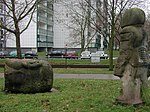
|
| Impressions | Klaus-Lutz Gaedicke | 175 × 133 × 43 cm, sandstone; a relief cuboid on a narrow base with indicated pipes and lines symbolizes the technoid labyrinth of a big city | between Fennpfuhl and Karl-Lade-Straße |

|
| Steles as wind and light play (1) | Horst Baudisch, Dieter Rühle | 135 × 70 × 45 cm / 170 × 45 × 45 cm, terracotta; originally there were 4 identical steles; three are no longer available, drawn up in 1989 |
Tram stop Anton-Saefkow-Platz | |
| Seat wall | unknown | Around 2004, an approximately 20 m long curved low wall was designed from yellow clinker bricks, which takes the building material of the former Lederkontor | between the bus stop and Franz-Jacob-Straße |

|
| Wall of water | Jürgen Karnopp | 260 × 2000 cm, molded ceramic bricks and clinker ; three water basins, offset in height, were fed by water gushing out from the wall | directly next to the stairs from the bus stop to Anton-Saefkow-Platz Covered with a trellis and green plants during the renovations in 2010/2011; the water is permanently turned off. |
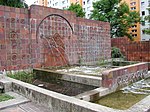
|
| lion | Georgi Filin (Bulgaria) | 102 x 285 x 110 cm; Made in 1987 from red sandstone and four individual parts | originally Karl-Lade-Straße, since around 2010 on the meadow directly on Anton-Saefkow-Platz |

|
| Greyhound (2) | unknown | two identical systems, approx. 5 m high | on a raised bed between the former department store and a grocery store Was not functional and was removed when the underground department store entrance was filled in in 2010. |

|
|
German resistance to fascism ( Der Entfesselte ) |
Siegfried Krepp | 335 × 120 × 120 cm, sandstone; naked male bodies were sculpted out of the stone block, they represent violence and rebellion and honor the Anton Saefkow resistance group | Made in 1986 and freely set up in 1989 directly on Anton-Saefkow-Platz | |
| Ball fountain or small fountain | Jürgen Karnopp | a square basin 360 × 360 cm, 50 cm high with rounded clinker elements; created and set up in 1984 | in the pedestrian area on Anton-Saefkow-Platz between two high-rise buildings; temporarily removed during renovation in autumn 2007, re-erected in 2008 |

|
| Erratic well | Lothar Scholz | a granite boulder weighing 26 t and around 2 m in diameter is located on an artificial concrete hill; the stone was found in the Fennpfuhl during construction. Originally, flowers were supposed to grow in crevices and between smaller stones placed on the boulder; water gushed out of the stone in summer | in the pedestrian area on Anton-Saefkow-Platz between two high-rise buildings; since the redesign of the boulevard only the boulder, water connection and concrete base are no longer available. |

|
| refrain | Juraj Gravula (Czechoslovakia) | 85 × 100 × 100 cm / 100 × 87 × 80 cm / 115 × 80 × 75 cm - three sandstone cubes, decorated with simple geometric shapes, lie at a crossroads | in the park near the sports hall |

|
| Wooden animals | probably Günter Schumann | Oversized, rugged wooden play equipment shows a hare, a turtle, a hippopotamus, hippopotamus and turtle first stood in the Lichtenberg city park |
northern edge of the park, near Landsberger Allee as a children's playground |
 · ·
|
| Wind chimes (3) mobile light object |
Horst Baudisch | Approx. 3 m high, in several parts and made of stainless steel, severely damaged in 1989, reconstructed by Goetz Dorl (Metallgestaltung from Berlin-Weißensee ) and re-erected in 1994 |
at the eastern park entrance, near the sports field on a hill |

|
In addition to the art objects listed above, the monumental fountain must also be mentioned, which was made of concrete according to a design by the architect Peter Schubring and has stood directly on Anton-Saefkow-Platz since 1985 . Because of its dilapidation, it stopped bubbling around 1990. In 2007, the Lichtenberg District Office organized a competition for renovation, which the artist Susanne Bayer won with a moss fountain . However, due to high costs, the design was not implemented and the remains of concrete were removed in November 2008. In 2009 the previous water basin was leveled. More towards the east, a small water feature made up of several fountains was put into operation in autumn 2010 , which can be computer-controlled.
The gable of the sports hall in the park area was decorated in 1984 by the painter Edmund Bechtle on the basis of the art concept with the motif beauty of movement .
Finally, the artistic objects realized in the Fennpfuhl Park include the ironwork with flower and bird motifs used on various path areas and as bridge parapets. They were made in 1982 in the Weißensee art forge based on designs by the artist Adam Kurtz and installed in 1986.
According to a plan from 1970, the following were not realized: a three-dimensional object as an artistic accent for access to the new residential area from Möllendorffstrasse (e.g. where the City Point Center has been located since the mid-1990s ), which describes the history of Lichtenberg should have as well as another up to 10 m high object made of architectural and artistic elements, which was planned as an open space component on the theme of the triumphal procession of the red star .
literature
- Art conception 1970, copy in the archive of the Heimatmuseum Lichtenberg
- Printed matter from BVV Lichtenberg, 1986, unpublished
Web links
Individual evidence
- ↑ Fennpfuhlpark at www.berlin.de; accessed on February 28, 2018.
- ↑ Open spaces at Anton-Saefkow-Platz in Berlin . In: Architektur , Issue 10, 1990.
- ↑ Roederstrasse . In: Address book for Berlin and its suburbs , 1900, part 5, Lichtenberg.
- ↑ Map section Berlin. far right: the two puddles and the ice works in the Wilhelmsberg area
- ↑ Peter Franke: When Lichtenberg was an aspiring village ... In: Lichtenberg-Hohenschönhausener , 12A / 2001
- ^ Postcard H. Mentes Volksgarten Lichtenberg in Roederstraße, 1902
- ↑ The 'Sea Doctor'. Ulrich Glaubrecht makes the heart of the Fennpfuhlsee beat . In: WGLi -Umschau , Heft 3, 2017, p. 5.
- ↑ Architectural monument Villa Karl-Lade-Strasse
- ↑ Weddings again soon . In: Berliner Zeitung , November 19, 2007
- ↑ New in Fennpfuhlpark . In: Lichtenberger Rathausnachrichten , November 3, 2007.
- ↑ Historical view of the lakeside terrace ( Memento of the original from March 30, 2013 in the Internet Archive ) Info: The archive link was inserted automatically and has not yet been checked. Please check the original and archive link according to the instructions and then remove this notice. .
- ↑ Locations of forced labor camps in the Lichtenberg district (PDF; 45 kB)
- ↑ Press release of December 21, 2017: Memorial steles renewed. Remembering the forced labor camp in the park at the Fennpfuhl
- ↑ Architect Eisentraut artist database
- ↑ Demolition of the "Seeterrassen" at the Fennpfuhl . In: Berliner Morgenpost online.
- ↑ Fennpfuhlpark has expanded. The Seeterrassen area is now one of them. In: Berliner Woche , June 9, 2010, local edition Lichtenberg, p. 8
- ↑ New fountain for the Fennpfuhl. In: Berliner Woche , May 26, 2010, local edition Lichtenberg, title page
- ↑ Pharmacies donate for natural monuments , brief information in the Berliner Woche , issue for Lichtenberg, from November 25, 2009, p. 2
- ^ Fennpfuhlfest HoWoGe, accessed on August 6, 2011.
- ↑ a b c d e Around the Fennpfuhl - outdoor museum. Series of hikes through Berlin, tour 28th Luisenstädtischer Bildungsverein , approx. 1996
- ^ Sylvia Brösicke-Istok, Gabriela Ivan, Romy Köcher, Hans Schlegel: Sculptures, monuments and fountains in the Lichtenberg district . Luisenstädtischer Bildungsverein , September 1993, ISBN 3-89542-012-3
- ↑ Homepage Ukrainian Sculptors with brief biographical information on Yuliy Synkevich, u. a. Birds of Tchernobyl ; accessed on September 21, 2015.
- ↑ Name according to the official shield attached to the group of figures; As of August 2011
- ↑ Information board on the wind chimes
- ^ Vita of Susanne Bayer. Retrieved October 5, 2009
- ^ Draft Moosbrunnen. Retrieved October 5, 2009
- ↑ 1986 according to a metal label attached to the railing
